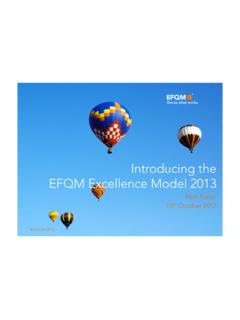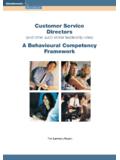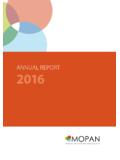Transcription of Beyond Budgeting as a mindset and a framework for action
1 1 Beyond Budgeting as a mindset and a framework for action Franz R sli and Santhosh Kaduthanam Agile, a trend that began in software development has been growing steadily in importance in the light of the unstoppable progress of digitisation in organisations. As traditional management approaches are failing, different organisational designs are needed to keep pace with these rapid developments. Beyond Budgeting is a holistic approach to achieve agility across the organisation. The Beyond Budgeting Round Table (BBRT) celebrates its 20th anniversary this year. It unites an international community of practitioners and researchers who developed the Beyond Budgeting organisational design and are continually developing it further.
2 Its pioneering achievement and mission is to look at organisations from a completely new perspective and consequently to design them to advance viability for the future. Beyond Budgeting : Pioneer of an agile organisational design At the core of Beyond Budgeting lies an agile, holistic approach based on self-organisation. Decentralised leadership and adaptive management processes are the two interlinked key dimensions of the Beyond Budgeting approach. Each of which comprises six principles. Recommendations for action in the form of dos and don'ts, which form the basis for the agility of organisations, are derived from this framework (see table on page 2). Self-organisation promotes agility The environment of organisations is becoming more and more demanding due to megatrends such as digitalisation, globalisation or mobility.
3 We are said to live in a VUCA world: V for volatility, U for uncertainty, C for complexity and A for ambiguity. Industries are converging, disruptive business models are penetrating traditional industries, and customers are increasingly buying online. All organisations today are faced with the need to cope with unforeseen events. As the unexpected becomes the norm, ability to plan is massively reduced. Surprisingly, however, the vast majority of companies still rely on stability and predictability in their organisational design. This is reflected, for example, in rigid hierarchies and centralised planning, which severely restrict a company s ability to act and react. This raises the question of how organisations can operate in a VUCA world.
4 Agility, meaning flexibility and manoeuvrability, but also greater resilience is essential to remaining viable in an increasingly unpredictable world. That is why a lot of attention has been paid in recent years to agile methods such as Scrum and Kanban. Their popularity extends far Beyond their original use, which was often in the field of software development. These agile methods are based on self-organisation, enabling individual projects in complex software environments to progress successfully. As a next step, the principle of self-organisation is transferred to the organisation as a whole, hence an agile organisational design being established throughout the company. This adds a new dimension that also affects the awareness and the self-image of the management.
5 This is where Beyond Budgeting comes in. Entrepreneurial (self-) organisation According to the traditional management idea, order is created through the actions of a body using predict and control: top management. Most business leaders still find it difficult to understand that organisations do not need centralised coordination. Research has shown, however, that centralised, top-down planning and control are not the best way to create order in complex adaptive systems. For organisational researcher Margaret Wheatley the following insight applies: The two forces that we have placed in opposition to each other freedom and order turn out to be partners in generating healthy, well-ordered systems. Effective self-organisation is supported by two critical elements: a clear sense of identity and freedom.
6 In organisations, if people are free to make their own decisions, guided by a clear organisational identity, the whole system develops greater coherence and strength. The organisation will thus become less regulatory, but at the same time more interconnected and aligned . In other words, effective coordination does not need a Table: The Beyond Budgeting approach: Two dimensions and twelve principles Coordination is designed into the system rather than imposed on the system. Good case studies for this organisational design from various regions and industries include dm-drogerie markt (Germany), Toyota (Japan), Trisa (Switzerland), Hilti (Liechtenstein), Svenska Handelsbanken (Sweden), HCL (India), Statoil (Norway), Haier (China) and Morning Star (United States).
7 At dm-drogerie markt, the leading German drugstore chain, a decentralised network of branches was implemented in the early 1990s replacing the hierarchical organisation. Branches were no longer controlled centrally by hierarchically set targets, but were empowered to control themselves through trust and competence. This not only resulted in more satisfied employees and lower employee turnover, it also gave the branches more flexibility to respond to regional and local differences in customer needs. That is why dm-drogerie markt has been able to remain very successful in today s fiercely contested drugstore market in contrast to other players such as Schlecker, which were unable to withstand the competitive pressure.
8 The ability to react appropriately to changes in the market environment is a vital advantage of trust-based, decentralised organisations, according to Beyond Budgeting . Trisa, a medium-sized family business in Switzerland and one of the world's leading toothbrush manufacturers, is making use of this advantage. By allowing its production managers to decide when to hire more workforce, Trisa can accommodate orders received at short notice that can amount to several million toothbrushes. In addition, all employees participate in the success of the company and are shareholders. The board of directors is composed of the founding family and employees equally. Most business leaders still find it difficult to understand that organisations do not need centralised coordination and control.
9 Goodbye to budgetary control In practice, Beyond Budgeting has often been regarded as a financial planning concept and has, therefore, been compared with methods such as advanced Budgeting or better Budgeting . This is misleading because Beyond Budgeting is a holistic organisational design, not a limited financial planning concept. Nevertheless, as a holistic approach Beyond Budgeting also addresses the inherently rigid and bureaucratic budget-based steering process. Without critical reflection of this process the epitome of bureaucracy a sustainable transformation to an agile organisation is highly unlikely, if not impossible to achieve. In almost every organisation a budget represents a financial plan and a financial target at the same time.
10 It thus forms not only a planning instrument for resource allocation but also the yardstick for assessing goal achievement and therefore the basis for distributing bonuses. Principles Dos Don ts Leadership 1. Purpose Engage and inspire people around bold and noble causes Not around short-term financial targets 2. Values Govern through shared values and sound judgement Not through detailed rules and regulations 3. Transparency Make information open for self-regulation, innovation, learning and control Don t restrict it 4. Organisation Cultivate a strong sense of belonging and organise around accountable teams Avoid hierarchical control and bureaucracy 5. Autonomy Trust people with freedom to act Don t punish everyone if someone should abuse it 6. Customers Connect everyone s work with customer needs Avoid conflicts of interest Management Processes 7.






